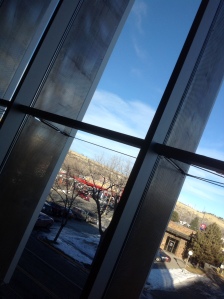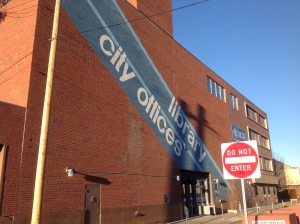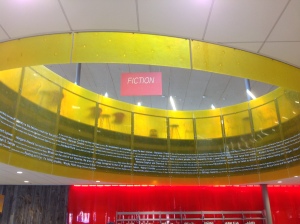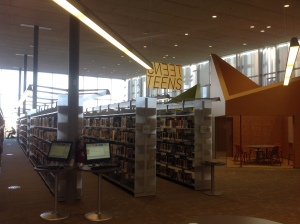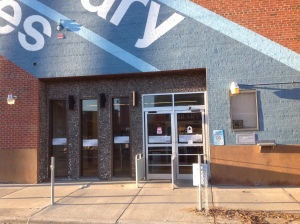I have arrived at the San Francisco Zen Center! Actually, I arrived at about this time yesterday. I know I promised to try and blog every day, but by the time I had the wi-fi password last night, I was tired, sweaty, and more than just a little bit overwrought with the upheaval of the day. Also my Internet connection is extremely spotty and temperamental here. Thus, no blog for Day 1. Commencing blog post for Day 2!
We are in interim right now at Zen Center, which means no early morning zazen meditation just yet. We’ll start back up again on Thursday. Until then, though, we get to sleep in a little. Breakfast is at 7:15. As a sidenote, I really have to say that being in an entirely vegetarian establishment is a remarkable relief. I had no idea how much of a relief it would be but it is very comforting to know that I can eat anything in the kitchen without worrying about jeopardizing my dietary morality.
Moving on!
Without zazen, the main focus today has been on the archives. Namely, we rolled up our sleeves (metaphorically-speaking—it’s surprisingly chilly in San Fran) and dug into the cloak room which is currently serving as the storage space for the archives. My understanding is that, ideally, Zen Center wants to return the cloak room to a more general storage facility. On Thursday of this week, the Bancroft Library at UC-Berkeley is coming to start a discussion with Zen Center (and us) so that we can look into donating a large portion of the materials to their archives. That will free up a considerable amount of space. The cloak room is very cramped and dark and there are a lot of boxes of materials! So, after digging out the boxes this morning, we had an Archives 101 session with our professor, Joe Tennis, this afternoon. I’m going to reprise what he taught us for two reasons: 1. It’s incredibly engrossing material for anyone who’s interested in archiving and preservation and 2. I need to revisit it myself to help me ingest it all.
The first thing to note is that librarians are NOT archivists. We like to think that we are. We very understandably believe that we can do anything we set our minds to. While this is not inaccurate, librarians are a remarkably capable bunch of folks, we do not necessarily know how to properly go about archiving a set of materials. In other countries, like Canada, archivists study the procedures, theories, and practices of archiving for fully two years without ever taking a class that remotely deals with what we would recognize as “librarianship.” Also, in the United States and most other Western countries (and increasingly globally), librarians are focused on access. We want to provide our patrons, our users with access to information so we are very preoccupied with how we can best provide that access. Archivists are concerned with authenticity and preservation, not necessarily access. Essentially, archivists want to preserve the identity and integrity of records. Librarians are NOT archivists. We must be aware of the limitations of our own training and we must respect those limitations. For further reading on archiving, check out the works of Luciana Durante and Geoffrey Yao.
Now that we have that out of the way, let’s delve into archiving in a little more detail.
Archivists deal with records (as opposed to publications, which librarians deal with). Records are evidence of an act or a fact. They are not necessarily intentionally published documents. For example, the personal correspondence of an abbot at Zen Center, while not something that has ever been published, would be considered a record. Moreover, you do not have to write a record to create a record. A letter from an abbot is not in and of itself considered a record. As soon as an organization (like Zen Center or the Bancroft Library) decides to set that letter aside and create an archival description for it, it becomes a record.
Identity, which so concerns archivists, deals with the name of every person who has ever been involved in a record. This can be anyone who has written the record, the receiver of the record, a person being discussed in the record, the person or people who are writing the record on behalf of someone else, etc. Identity also concerns the action or matter or the record and the handling responsibilities or offices related to the record.
The second aim of archivists is to preserve the integrity of materials. This means recording the provenance of a record from creation to archiving. For example, a letter from an abbot might have originated with that abbot, then been moved from his files to the cloak room storage at City Center, then moved to the Bancroft Library. Both identity and integrity are of vital importance in archiving because, remember, archiving deals with evidence of an act or a fact. It is crucial that this evidence be authentic to provide as accurate a picture as possible. It is the role of the archivist or preserver to authenticate records. Sometimes, quite often in fact, this involves deciding what is worth archiving and what is not. However, the archivist’s discretion is not at all cut and dried. Sometimes, records only derive their meaning from their context and simply plucking those records out of that context can render a record meaningless. Great care must be taken to maintain original context inasmuch as is possible.
This concept is known as fonds d’archives. It originated in France in 1841 as a way of organizing archival records contextually instead of by subject, as many libraries and bookstores are organized. This practice really emphasizes respect for the creator of works.
As a shorthand, fonds d’archives is known as simply fonds. It refers to the overarching, most general, contextual level of archival materials. Below that is the sub-fonds level. Then come, in descending order, the series, folder, and item levels of archival description. It is rather rare to reach the item level for most records. However, Joe has told us that we may indeed do so should the Bancroft Library decide to acquire some of the original art contained in the Zen Center archives.
Archival description commences once a record has crossed the threshold of identification for preservation. In essence, it begins as soon as someone decides to create a record. This description is the same concept as a bibliographic description for a library record, however it looks very different. A library record for a published work usually includes title, author, physical description, subject terms, and publishing information. An archival description provides a creator (who created the record, not who originated the work), an administrative history (what was the hierarchy of the organization at the time of origination), the extent of the records (usually given in cubic feet), and, rarely, a title.
I am trying to train myself out of the practice of referring to archives as “collections.” A more preferred term is “materials.” “Collection” carries the implication of scope and curation. My high school library has a collection. It has a defined scope and we weed it every year to further focus that scope and to maintain its relevance to our patrons. Archives are not curated! They are an organic accretion of material over the course of time. While the archivist does make initial decisions about what gets saved and what doesn’t, usually once the materials have been archived they are not further weeded unless there are space crises or other extenuating circumstances.
That initial determination by an archivist or preserver usually results in an archival appraisal report. We’ll get to create one of these for the Bancroft Library! This report indicates what should be saved and what should be discarded and when. Many parties, and varied parties, go into making these decisions. For example, Zen Center’s maintenance of financial records will be determined as much by Zen Center’s administration and its archiving team as by California state guidelines for nonprofit organizations. For the personal materials of a specific individual, one practice is to wait until 7 years after that individual’s death before releasing those records to an archive. It varies greatly.
The last thing I want to mention (I know, it’s been a very long post, but I learned a lot today!) is the practice known as “total archives.” Total archives advocates for the maintenance of absolutely ALL materials from an individual or organization. One way this has played out is in the modern practice of capturing art studios photographically for archives of artists’ works. By generating the context of art in photographs, we are able to lend even further meaning to the original intention and efforts behind those works. Based upon my considerable time spent as an undergraduate studying for my art history minor, I can certainly appreciate the value of this practice. Seeing Jackson Pollock or Willem de Kooning at work in their studios allowed for a deeper understanding of their work and process. It added greatly to my appreciation of their work and its importance in art history. So while I don’t know that I’m a die-hard supporter of total archives, I can definitely see their benefits!
More tomorrow!


